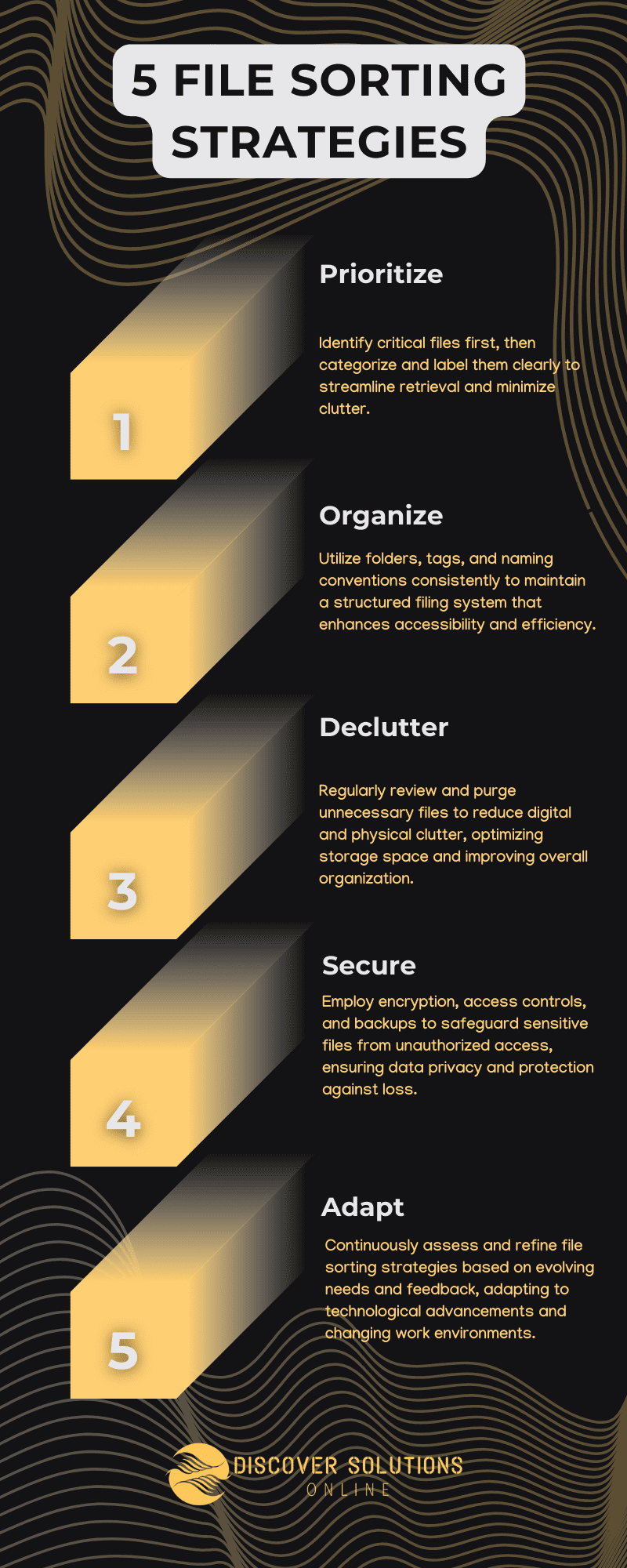Disorderly file sorting doesn’t just affect productivity, it also takes a toll on the psychological well-being of individuals within an organization. The chaos and confusion caused by disorganized files can lead to feelings of overwhelm, helplessness, and anxiety. When essential documents are buried amidst cluttered folders or scattered across multiple locations, employees may experience a sense of frustration and inadequacy as they struggle to locate critical information.
Moreover, the inability to find files promptly can trigger a cascade of negative emotions, from stress and irritation to panic and despair. This constant battle against disorder can erode morale, sap motivation, and contribute to a pervasive sense of disarray within the workplace. Over time, the psychological burden of unresolved chaos can take a significant toll on mental resilience, impairing cognitive function, and hindering overall well-being.
Addressing the psychological impact of disorderly file sorting requires more than just organizational efficiency; it necessitates a concerted effort to cultivate a work environment that prioritizes clarity, order, and peace of mind. By implementing effective file management strategies and promoting a culture of organizational tidiness, businesses can mitigate the psychological toll of disorder and create a healthier, more harmonious workplace for their employees.
Stress and Frustration Caused by Disorganized Files
In the realm of modern business operations, where digitalization has become the norm, the management and organization of files hold paramount importance. Whether it’s legal documents, financial records, or project files, the efficiency of an organization greatly depends on the systematic sorting and arrangement of its data. Disorderly file sorting, on the other hand, can be a source of immense stress and frustration for individuals and teams alike.
The Cognitive Load of Disorder
Disorderly file sorting imposes a significant cognitive load on individuals. Picture this: You’re on a tight deadline, searching for a crucial document buried somewhere amidst a cluttered array of folders and files. The minutes tick by as frustration mounts, productivity dwindles, and stress levels soar. This scenario is all too familiar in workplaces where file organization takes a backseat.
Studies in cognitive psychology have shown that disorganization can impair cognitive function, leading to decreased productivity and increased stress. When files are scattered haphazardly across drives or cloud storage, employees are forced to expend valuable mental energy navigating through the chaos. This constant mental juggling can drain cognitive resources, leaving individuals feeling overwhelmed and frazzled.
Impact on Productivity
Productivity is the lifeblood of any organization, and disorderly file sorting poses a direct threat to this vital aspect of business operations. Time wasted searching for misplaced files translates into missed deadlines, delayed projects, and ultimately, lost revenue. Moreover, the frustration stemming from fruitless searches can further dampen motivation and morale, creating a vicious cycle of inefficiency.
Research conducted by productivity experts has highlighted the significant productivity costs associated with disorganized files. According to a survey by Forbes, employees spend an average of 4.3 hours per week searching for documents, with nearly 20% of their workweek wasted on this unproductive endeavor. Multiply this across an entire workforce, and the cumulative impact on organizational productivity becomes glaringly evident.
Psychological Toll
Beyond its tangible effects on productivity, disorderly file sorting can exact a heavy psychological toll on individuals. The constant battle against clutter and disarray can breed feelings of helplessness, inadequacy, and even anxiety. As deadlines loom and pressure mounts, the inability to locate essential documents can trigger a cascade of negative emotions, ranging from frustration to panic.
Psychologists have long recognized the link between environmental disorder and mental well-being. Just as a cluttered physical space can contribute to feelings of stress and anxiety, a disorganized digital environment can have similar psychological ramifications. The subconscious burden of unresolved chaos can weigh heavily on the mind, impairing concentration, sapping energy, and eroding overall mental resilience.
Strained Collaborations and Communication
In today’s collaborative work environments, effective communication and seamless information sharing are paramount. However, disorderly file sorting can impede these essential aspects of teamwork, creating barriers to collaboration and hindering the flow of information. When team members struggle to locate and access shared files, projects can grind to a halt, and interdepartmental communication can break down.
The frustration of grappling with disorganized files can also strain interpersonal relationships within the workplace. Misplaced blame, misunderstandings, and conflict may arise as a result of communication breakdowns stemming from file-related issues. In the absence of clear organizational protocols for file management, resentment can fester, eroding trust and cohesion within teams.
Strategies for Disorderly File Sorting
To address the stress and frustration caused by disorganized files, proactive measures are crucial for streamlining file management and fostering organizational tidiness. Strategies for mitigating the negative impact of disorderly file sorting include implementing robust file organization systems with software solutions that facilitate efficient sorting and retrieval. Clear naming conventions should be established to promote consistency and clarity, while providing training and ongoing support for employees to navigate digital assets effectively. Regular maintenance audits and decluttering efforts help maintain organizational efficiency, along with promoting collaboration tools for seamless document sharing and version tracking. Encouraging accountability and ownership of file management tasks among team members further strengthens the organization’s file organization efforts.
The Psychological Impact of Disorderly File Sorting
File sorting, a seemingly mundane task, is a fundamental aspect of organizational operations in today’s digitally-driven work environments. It involves the systematic organization and categorization of legal documents, case files, evidence, and other pertinent materials. However, disorderly file sorting can have far-reaching implications beyond mere inconvenience. In this comprehensive exploration, we delve into the various ways in which disorderly file sorting affects mental health in the workplace and explore effective strategies for improvement.
Understanding Disorderly File Sorting
Before delving into its psychological impact, it’s crucial to understand what disorderly file sorting entails. Disorderly file sorting refers to the lack of organization and structure in managing digital files and documents. It manifests in various forms, including inconsistent naming conventions, haphazard folder structures, and cluttered digital workspaces. Without clear organization and categorization, finding specific files becomes a daunting task, leading to frustration and inefficiency.
Stress and Anxiety: The Immediate Consequences
One of the most immediate consequences of disorderly file sorting is the heightened levels of stress and anxiety experienced by employees. Picture this scenario: You’re on a tight deadline, and you urgently need to access a crucial document buried within a maze of disorganized files. As minutes turn into hours, frustration mounts, and stress levels soar. This constant pressure to navigate through cluttered digital environments can take a significant toll on mental health.
Research has shown that chronic stress in the workplace can lead to a myriad of adverse health outcomes, including anxiety disorders, depression, and burnout. The inability to locate essential documents due to disorderly file sorting only exacerbates these issues, creating a cycle of stress and anxiety that undermines employee well-being and productivity.
Feelings of Overwhelm and Helplessness: Losing Control
Disorderly file sorting can also evoke feelings of overwhelm and helplessness among employees. When faced with a sea of unorganized files, individuals may struggle to prioritize tasks, make decisions, or maintain a sense of control over their workload. The constant battle against chaos can leave employees feeling powerless and demoralized, eroding their confidence and sense of self-efficacy.
Moreover, the inability to effectively manage digital clutter can spill over into other areas of work and life, contributing to a sense of overwhelm that permeates every aspect of daily existence. As the lines between professional and personal responsibilities blur, employees may find it increasingly challenging to switch off from work-related stressors, further exacerbating mental health issues.
Reduced Productivity and Performance: The Business Impact
From a business perspective, the implications of disorderly file sorting extend beyond the individual to impact overall productivity and performance. When employees are bogged down by the inefficiencies of disorganization, their ability to focus, concentrate, and deliver high-quality work is compromised. This can lead to missed deadlines, errors, and subpar outcomes for projects, ultimately affecting the bottom line of the organization.
Furthermore, the psychological burden of unresolved chaos can impede cognitive function, impairing memory, attention, and problem-solving skills. As individuals struggle to keep up with the demands of a cluttered digital workspace, their capacity to perform at their best is diminished, perpetuating a cycle of underperformance and frustration.
Addressing the Issue: Improving Mental Health in the Workplace
Improving mental health in the workplace requires a multifaceted approach that prioritizes both organizational and individual well-being. Recognizing the importance of efficient file management and taking steps to support mental well-being, organizations can mitigate the negative effects of disorderly file sorting and create a healthier, more productive work environment for all employees.
By implementing efficient file management systems, promoting clear communication and expectations, providing training and support, encouraging regular breaks and boundaries, fostering a culture of flexibility and adaptability, leading by example, and offering employee assistance programs (EAPs), organizations can address the root causes of disorderly file sorting and promote mental well-being in the workplace. By prioritizing mental health and well-being, organizations can create a positive work environment where employees can thrive.
Strategies for Managing Information Overload
In today’s digital age, where the volume of information continues to grow exponentially, managing information overload has become a critical challenge for individuals and organizations alike. File sorting, a process that involves the systematic organization and categorization of legal documents, case files, evidence, and other pertinent materials, plays a crucial role in navigating this deluge of data. In this section, we’ll explore effective strategies for managing information overload and maintaining productivity in the face of digital chaos.
Understanding the Complexity of Information Overload
Before delving into strategies for managing information overload, it’s essential to understand the complexity of the problem. Information overload refers to the situation where individuals are exposed to more information than they can effectively process or manage. This overload can lead to feelings of overwhelm, decreased productivity, and difficulty in making decisions. In today’s interconnected world, where information is constantly bombarding us from various sources such as emails, social media, news websites, and digital documents, the challenge of managing information overload has become more acute than ever before.
Prioritize Organization and Structure
The cornerstone of managing information overload is prioritizing organization and structure. Establishing clear systems for file sorting and categorization is essential for maintaining a sense of order amidst the chaos of digital clutter. Implement consistent naming conventions, create logical folder structures, and utilize metadata and tags to enhance searchability and accessibility. By organizing files in a systematic manner, individuals can streamline their workflow and quickly locate the information they need, reducing the cognitive burden of information overload.
Utilize Technology Solutions
In addition to manual organization methods, leveraging technology solutions can significantly aid in managing information overload. Invest in robust file management software that offers advanced features such as automatic categorization, intelligent search capabilities, and version control. These tools not only simplify the process of file sorting but also provide insights into usage patterns and document history, facilitating better decision-making and collaboration.
Implement Time Management Techniques
Effective time management is crucial for managing information overload and maintaining productivity. Implement techniques such as the Pomodoro Technique, time blocking, or the Eisenhower Matrix to prioritize tasks and allocate dedicated time slots for file sorting and organization. By breaking tasks into manageable chunks and establishing focused work periods, individuals can avoid feeling overwhelmed by the sheer volume of information and make steady progress towards their goals.
Establish Information Filters
In the age of information overload, it’s essential to establish effective information filters to separate the signal from the noise. Identify key sources of information that are most relevant to your work or interests and curate them carefully. Subscribe to newsletters, set up RSS feeds, or utilize content aggregation tools to consolidate relevant information in one place while filtering out irrelevant or low-priority content. By proactively managing the flow of information, individuals can stay informed without becoming overwhelmed by unnecessary distractions.
Cultivate Mindfulness Practices
Mindfulness practices offer valuable tools for managing information overload and promoting mental well-being. Incorporate mindfulness techniques such as meditation, deep breathing exercises, or mindful breaks into your daily routine to cultivate a sense of calm and focus amidst the digital noise. By grounding yourself in the present moment and tuning into your thoughts and sensations, you can reduce stress and enhance your ability to manage information overload effectively.
Delegate and Collaborate
Recognize that managing information overload is not solely an individual responsibility but also a collective endeavor. Delegate tasks, collaborate with colleagues, and leverage the expertise of others to streamline the process of file sorting and organization. Establish clear communication channels and collaboration tools to facilitate seamless sharing and collaboration on documents, reducing duplication of effort and maximizing productivity across teams.
Continuously Evaluate and Adjust
Finally, recognize that managing information overload is an ongoing process that requires continuous evaluation and adjustment. Regularly review your file sorting systems, information sources, and time management techniques to identify areas for improvement and make necessary adjustments. Stay adaptable and open to trying new strategies and tools to optimize your workflow and maintain productivity in the face of evolving information challenges.
Practical Tips for Implementing Effective File Sorting Systems

Implementing an effective file sorting system is crucial for maintaining organization, efficiency, and peace of mind in any organization. Disorderly files can lead to frustration, wasted time, and even legal or compliance issues. To help you tackle this challenge, here are some practical tips for implementing effective file sorting systems:
Start with a Comprehensive Audit
Before diving into organizing your files, conduct a comprehensive audit of your current file system. Identify the types of files you have, where they are stored, and how they are currently organized. This audit will provide valuable insights into your organization’s file management needs and challenges, guiding the development of your sorting system.
Define Clear Categories and Subcategories
Based on the results of your audit, define clear categories and subcategories for organizing your files. Consider the different types of documents you deal with and how they relate to each other. Create broad categories for overarching topics or departments, and then break them down into more specific subcategories as needed. This hierarchical structure will make it easier to locate files quickly and intuitively.
Develop Consistent Naming Conventions
Establish consistent naming conventions for your files to ensure uniformity and clarity. Choose descriptive and informative filenames that accurately reflect the content of each document. Include relevant details such as dates, project names, or client names to make it easier to identify files at a glance. Consistent naming conventions will facilitate efficient searching and sorting of files across your organization.
Leverage Metadata and Tags
Take advantage of metadata and tagging features available in modern file management systems. Assign relevant metadata to each file, such as keywords, authors, or document types, to provide additional context and enhance searchability. Use tags to categorize files based on specific attributes or topics, allowing for flexible sorting and filtering options. Metadata and tags can significantly improve the organization and accessibility of your files.
Implement Version Control
Implement a version control system to track changes and revisions to your documents. Assign unique version numbers or timestamps to each iteration of a file and maintain a log of changes over time. Version control will help prevent confusion and ensure that everyone is working with the most up-to-date information. It also provides a valuable audit trail for tracking document history and resolving disputes.
Provide Training and Support
Invest in training and support for your employees to ensure they understand how to use the new file sorting system effectively. Offer workshops, tutorials, or online resources to familiarize them with the system’s features and best practices. Encourage feedback and questions to address any concerns or challenges they may encounter. Training and support are essential for successful adoption and implementation of the new system.
Establish Regular Maintenance Procedures
Set up regular maintenance procedures to keep your file sorting system clean and up-to-date. Schedule periodic reviews to identify outdated or redundant files and remove them as needed. Update file categories or naming conventions as your organization evolves to reflect changes in workflow or priorities. Regular maintenance will prevent clutter and ensure that your file sorting system remains efficient and effective over time.
Monitor and Evaluate Performance
Monitor the performance of your file sorting system on an ongoing basis to identify areas for improvement. Track metrics such as search time, file retrieval speed, and user satisfaction to gauge the system’s effectiveness. Solicit feedback from employees to learn about their experiences and any pain points they encounter. Use this information to make adjustments and refinements to the system as needed.
Foster a Culture of Organization
Promote a culture of organization and accountability within your organization to ensure the success of your file sorting system. Encourage employees to adhere to established filing protocols and take ownership of their files and documents. Recognize and reward individuals or teams that demonstrate exemplary organization skills and contribute to the overall efficiency of the system. A culture of organization will help sustain the effectiveness of your file sorting system in the long run.
Stay Flexible and Adapt
Finally, stay flexible and adaptable in your approach to file sorting. Recognize that organizational needs and priorities may change over time, requiring adjustments to your sorting system. Stay informed about new technologies and best practices in file management and be willing to incorporate them into your system as appropriate. By staying flexible and adaptable, you can ensure that your file sorting system remains relevant and effective in meeting the evolving needs of your organization.
Implementing an effective file sorting system requires careful planning, attention to detail, and ongoing maintenance. By following these practical tips, you can develop a system that promotes organization, efficiency, and productivity throughout your organization.
Discover Solutions Online: File Sorting Specialists
Discover Solutions Online specializes in file sorting. With a focus on efficiency and effectiveness, we streamline file management processes, providing clients with structured approaches. Through customized strategies, clear communication, and ongoing support, we empower individuals to regain control over their files, reducing stress and improving productivity. As file sorting specialists, we are committed to delivering solutions that promote clarity, organization, and peace of mind.
Structured Approach
Discover Solutions Online employs a structured approach to file sorting projects, ensuring that files are organized in a logical and intuitive manner. This structured organization helps reduce the cognitive burden on individuals trying to navigate disorderly files, thus alleviating feelings of frustration and overwhelm.
Customized Solutions
We understand that every client’s file sorting needs are unique. Our team works closely with clients to tailor solutions that align with their specific requirements and preferences. By providing customized solutions, we empower individuals to regain a sense of control over their digital environment, reducing anxiety associated with disorderly file sorting.
Efficiency and Time Savings
Disorderly file sorting can be a time-consuming and mentally draining task. Discover Solutions Online utilizes efficient file sorting techniques and tools to streamline the process, saving clients valuable time and energy. By efficiently organizing files, we help alleviate stress and anxiety stemming from the overwhelming nature of disorderly digital environments.
Clear Communication and Guidance
Our team prioritizes clear communication and guidance throughout the file sorting process. We provide clients with detailed instructions, tips, and ongoing support to ensure they feel confident and empowered to tackle their disorderly files. Clear communication helps mitigate feelings of confusion and frustration, promoting a more positive and stress-free experience.
Long-term Sustainability
Our goal is not only to help clients achieve immediate relief from disorderly file sorting but also to establish long-term sustainable systems that promote ongoing organization and clarity. Through education, training, and the implementation of effective file management strategies, Discover Solutions Online equips clients with the tools and knowledge they need to maintain order and minimize future stress related to file chaos.
Focus on Mental Well-being
Recognizing the psychological impact of disorderly file sorting, Discover Solutions Online places a strong emphasis on promoting mental well-being throughout the process. We prioritize creating a supportive and encouraging environment where clients feel comfortable expressing their concerns and seeking assistance. By addressing the emotional aspect of file sorting, we aim to alleviate stress and promote a sense of relief and satisfaction.
In Conclusion, disorderly file sorting transcends inconvenience, manifesting in heightened stress, reduced productivity, and strained collaborations. Efficient file management emerges as a strategic imperative, fostering a healthy work environment. Recognizing its significance goes beyond convenience, shaping a culture of organizational tidiness vital for unleashing workforce potential. Through robust file sorting systems and a commitment to mental well-being, businesses can mitigate disorder’s toll, nurturing a productive and harmonious workplace.





